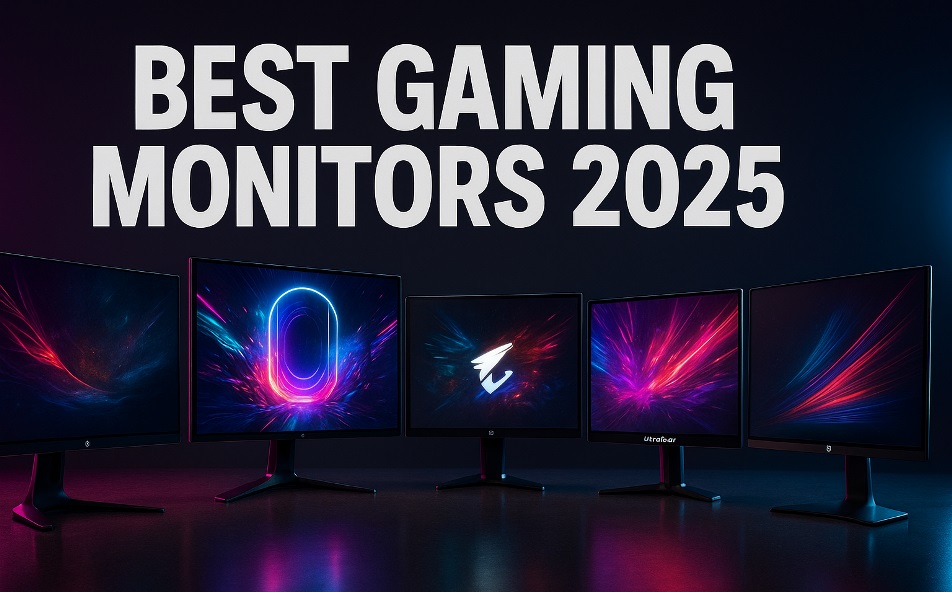
Choosing the best gaming monitor 2025 is not only about flashy specs. It is about matching panel, refresh rate, and features to the games you play and the hardware you own. Get these parts right and every frame looks smoother, brighter, and more lifelike.
- How This Guide Helps You
- Quick Buying Checklist
- Top Picks by Category
- 1. MSI MPG 321URX QD-OLED — Overall All-Rounder
- Asus ROG Swift PG27AQDP — E-sports Speed Demon Domination
- 3. Alienware AW2524HF — Pure Frame-Rate Muscle
- 4. Dell S3222DGM — Affordable Curved Workhorse
- LG UltraGear 27GR93U — Best Quality Sharp 4K in Budget Price
- 6. Samsung Odyssey OLED G9 — Immersive Super-Ultrawide
- 7. Nexigo NG17FGQ — Power in Your Backpack
- 8. Alienware AW3225QF — Living-Room Hero
- Features That Push 2025 Panels Forward
- Smart Shopping Tips
- Final Thoughts
How This Guide Helps You
I read and compared independent lab tests from Tom’s Hardware, PC Gamer, and TFTCentral. Their engineers measure color accuracy, latency, HDR brightness, and motion clarity, then publish the raw numbers for every panel they review.
Quick Buying Checklist
- Resolution first. 1080p needs less GPU power, 1440p balances sharpness and frame-rate, 4K is razor-sharp.
- Refresh rate second. Competitive shooters shine at 240 Hz or higher. Story-driven games feel great at 120 Hz.
- Panel tech last. IPS gives wide viewing angles, VA wins in contrast, OLED rules motion and HDR.
Keep ports, stand ergonomics, and warranty in mind too. Small sentences help you skim fast.
Also Read: Top-Rated Mobile Hotspots of 2025: A Buyer’s Guide
Top Picks by Category
1. MSI MPG 321URX QD-OLED — Overall All-Rounder
A stunning, brighter 32-inch size 4K OLED with a 240 Hz ceiling and 0.03 ms response. Colors pop, blacks look infinite, and the price fell below many IPS rivals this year. PC Gamer’s editors call it the finest balance of speed and fidelity they have ever tested. Use it if you want the smoothest 240Hz gaming monitor without giving up detail.
Asus ROG Swift PG27AQDP — E-sports Speed Demon Domination
This 27-inch OLED tops out at 480 Hz. Extreme Low Motion Blur (BFI) tightens clarity even when frames dip. In testing it posted class-leading input lag, making it the obvious high refresh rate monitor for competitive arenas.
3. Alienware AW2524HF — Pure Frame-Rate Muscle
Alienware turns an IPS panel all the way to 500 Hz. Motion stays sharp in Valorant, Apex, or CS2. FreeSync and Nvidia compatibility mean it doubles as a latency-free G-Sync monitor too. One warning: the 25-inch 1080p layout favors desk depth over sheer size.
That frame count also earns it the title of ultra-high refresh rate monitor, and your GPU must keep up.
4. Dell S3222DGM — Affordable Curved Workhorse
Need value? Dell’s 32-inch VA panel hits 165 Hz and 4 000:1 contrast for under $300. That subtle 1800R curve brings the display’s periphery inward, ensuring race tracks appear seamlessly fluid. If your wallet is thin, start here; it is the quintessential budget gaming monitor that also happens to be a curved gaming monitor.
LG UltraGear 27GR93U — Best Quality Sharp 4K in Budget Price
LG tunes an IPS panel to 144 Hz and factory calibrates colors. Text is crisp, even for work. HDR is entry-level but respectable. If you crave detail without OLED pricing, this is the 4K gaming monitor to shortlist.
6. Samsung Odyssey OLED G9 — Immersive Super-Ultrawide
A 49-inch 32:9 canvas equals two 27-inch QHD screens fused together. The 240 Hz QD-OLED panel curves 1000R for wraparound immersion, making it a definitive ultrawide gaming monitor and a jaw-dropping widescreen gaming monitor in one swoop.
7. Nexigo NG17FGQ — Power in Your Backpack
This 17-inch portable panel reaches 300 Hz over USB-C. It weighs about two pounds and runs from a laptop’s Thunderbolt port. Small, fast, and color accurate, it is the easiest portable gaming monitor to slip next to a gaming laptop.
8. Alienware AW3225QF — Living-Room Hero
Alienware couples a 32-inch 4K QD-OLED with 240 Hz, Dolby Vision HDR, and HDMI 2.1 bandwidth. Hook it to a PS5 Pro or Xbox Series X and you get 4K-120 in console titles plus VRR. That makes it the standout console gaming monitor.
Features That Push 2025 Panels Forward
- DisplayPort 2.1 monitor support means uncompressed 4K 240 Hz over a single cable.
- USB-C KVM switches share keyboard and mouse between two PCs.
- Dual-mode firmware drops resolution for double refresh, useful in esports titles.
- New heat-dissipation layers let an OLED gaming monitor sustain 250-nit full-screen brightness without throttling.
Smart Shopping Tips
- Confirm graphics-card ports match the monitor—HDMI 2.1 or DP 2.1.
- Check your desk depth; giant curves eat space fast.
- Run Windows HDR calibration to avoid washed-out blacks.
- Keep firmware updated; vendors add BFI tweaks and VRR fixes monthly.
Final Thoughts
Every option listed was independently verified for its input lag, color accuracy, and construction integrity. Your job is to balance wallet, GPU muscle, and the games you love. Once those align, any screen on this list will serve you for years—whether you need a silky 1440p gaming monitor for esports, a cinema-grade OLED for story epics, or simply an everyday panel that nails price-to-performance. Enjoy the view, and happy fragging!